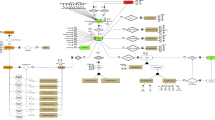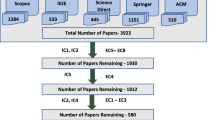Abstract
Context-aware systems acquire and exploit information on the user context to tailor services to a particular user, place, time, and/or event. Hence, they allow service providers to adapt their services to actual user needs, by offering personalized services depending on the current user context. Service providers are usually interested in profiling users both to increase client satisfaction and to broaden the set of offered services. Novel and efficient techniques are needed to tailor service supply to the user (or the user category) and to the situation in which he/she is involved. This paper presents the CAS-Mine framework to efficiently discover relevant relationships between user context data and currently asked services for both user and service profiling. CAS-Mine efficiently extracts generalized association rules, which provide a high-level abstraction of both user habits and service characteristics depending on the context. A lazy (analyst-provided) taxonomy evaluation performed on different attributes (e.g., a geographic hierarchy on spatial coordinates, a classification of provided services) drives the rule generalization process. Extracted rules are classified into groups according to their semantic meaning and ranked by means of quality indices, thus allowing a domain expert to focus on the most relevant patterns. Experiments performed on three context-aware datasets, obtained by logging user requests and context information for three real applications, show the effectiveness and the efficiency of the CAS-Mine framework in mining different valuable types of correlations between user habits, context information, and provided services.
Similar content being viewed by others
References
Agrawal R, Imielinski T, Swami AN (1993) Mining association rules between sets of items in large databases. In: Buneman P, Jajodia S (eds) SIGMOD conference. ACM Press, New york, pp 207–216
Agrawal R, Srikant R (1994) Fast algorithms for mining association rules in large databases. In: Bocca JB, Jarke M, Zaniolo C (eds) VLDB. Morgan Kaufmann, Los Altos, pp 487–499
Antonie M-L, Zaïane OR, Coman A (2001) Application of data mining techniques for medical image classification. In: Zaïane OR, Simoff SJ (eds) MDM/KDD. University of Alberta, Edmonton, pp 94–101
Baralis E, Cagliero L, Cerquitelli T, D’Elia V, Garza P (2010) Support driven opportunistic aggregation for generalized itemset extraction. In: IEEE conference of intelligent systems. IEEE, pp 102–107
Baralis E, Cagliero L, Cerquitelli T, Garza P, Marchetti M (2009) Context-aware user and service profiling by means of generalized association rules. In: Velásquez JD, Ríos SA, Howlett RJ, Jain LC (eds) KES (2), vol 5712 of Lecture Notes in Computer Science. Springer, Berlin, pp 50–57
Bolchini C, Curino C, Quintarelli E, Schreiber FA, Tanca L (2007) A data-oriented survey of context models. SIGMOD rec 36(4): 19–26
Bradley NA, Dunlop MD (2005) Toward a multidisciplinary model of context to support context-aware computing. Hum Comput Interact 20(4): 403–446
Byun H, Cheverst K (2004) Utilizing context history to provide dynamic adaptations. Appl Artifici Intell 18(6): 533–548
Cong G, Tung AKH, Xu X, Pan F, Yang J (2004) Farmer: finding interesting rule groups in microarray datasets. In: Weikum G, König AC, Deßloch S (eds) SIGMOD conference. ACM, pp 143–154
Daoud M, Tamine-Lechani L, Boughanem M (2009) Towards a graph-based user profile modeling for a session-based personalized search. Knowl Inf Syst 21(3): 365–398
Häkkilä J, Mäntyjärvi J (2005) Collaboration in context-aware mobile phone applications. HICSS, IEEE Computer Society, p 33a
Han J, Fu Y (1995) Discovery of multiple-level association rules from large databases. In: Dayal U, Gray PMD, Nishio S (eds) VLDB. Morgan Kaufmann, Los Altos, pp 420–431
Han J, Fu Y (1999) Mining multiple-level association rules in large databases. IEEE Trans Knowl Data Eng 11(5): 798–804
Han J, Pei J, Yin Y (2000) Mining frequent patterns without candidate generation. In: Chen W, Naughton JF, Bernstein PA (eds) SIGMOD conference. ACM, New york, pp 1–12
Heuer A, Lubinski A (1998) Data reduction—an adaptation technique for mobile environments. Interactive Applications of mobile Computing (IMC’98), pp 1–2
Hipp J, Myka A, Wirth R, Güntzer U (1998) A new algorithm for faster mining of generalized association rules. In: Zytkow JM, Quafafou M (eds) PKDD, vol 1510 of Lecture Notes in Computer Science. Springer, Berlin , pp 74–82
Hong J, Suh E, Kim S-J (2009) Context-aware systems: a literature review and classification. Expert Syst Appl 36(4): 8509–8522
Jameson A (2001) Modelling both the context and the user. Pers Ubiquitous Comput 5(1): 29–33
Jiang T, Tuzhilin A (2009) Improving personalization solutions through optimal segmentation of customer bases. IEEE Trans Knowl Data Eng 21(3): 305–320
Lee B-H, Kim H-N, Jung J-G, Jo G (2006) Location-based service with context data for a restaurant recommendation. In: Bressan S, Kü ng J, Wagner R (eds) DEXA, vol 4080 of Lecture Notes in Computer Science. Springer, pp 430–438
Leung KW-T, Lee DL (2010) Deriving concept-based user profiles from search engine logs. IEEE Trans Knowl Data Eng 22(7): 969–982
Liu B, Hsu W, Mun L-F, Lee H-Y (1999) Finding interesting patterns using user expectations. IEEE Trans Knowl Data Eng 11(6): 817–832
Nurmi P, Salden AH, Lau SL, Suomela J, Sutterer M, Millerat J, Martin M, Lagerspetz E, Poortinga R (2006) A system for context-dependent user modeling. In: Meersman R, Tari Z, Herrero P (eds) OTM workshops (2) vol 4278 of Lecture Notes in Computer Science. Springer, pp 1894–1903
Oliver N, Garg A, Horvitz E (2004) Layered representations for learning and inferring office activity from multiple sensory channels. Comput Vis Image Underst 96(2): 163–180
Pramudiono I, Kitsuregawa M (2004) Fp-tax: tree structure based generalized association rule mining. In: Das G, Liu B, Yu PS (eds) DMKD. ACM, New york, pp 60–63
Python (2009) Python website. http://www.python.org
Shen B, Yao M, Wu Z, Gao Y (2010) Mining dynamic association rules with comments. Knowl Inf Syst 23(1): 73–98
Singh S, Vajirkar P, Lee Y (2003) Context-based data mining using ontologies. In: Song I-Y, Liddle SW, Ling TW, Scheuermann P (eds) ER, vol 2813 of Lecture Notes in Computer Science. Springer, pp 405–418
Srikant R, Agrawal R (1995) Mining generalized association rules. In: Dayal U, Gray PMD, Nishio S (eds) VLDB. Morgan Kaufmann, Los Altos, pp 407–419
Srikant R, Agrawal R (1996) Mining quantitative association rules in large relational tables. In: Jagadish HV, Mumick IS (eds) SIGMOD conference. ACM Press, pp 1–12
Srikant R, Vu Q, Agrawal R (1997) Mining association rules with item constraints. In: Heckerman D, Mannila H, Pregibon D (eds) KDD. AAAI Press, Menlo Park, USA, pp 67–73
Sriphaew K, Theeramunkong T (2002) A new method for finding generalized frequent itemsets in generalized association rule mining. ISCC, IEEE Computer Society, pp 1040–1045
Tamine-Lechani L, Boughanem M, Daoud M (2010) Evaluation of contextual information retrieval effectiveness: overview of issues and research. Knowl Inf Syst 24(1): 1–34
Tan P-N, Kumar V, Srivastava J (2002) Selecting the right interestingness measure for association patterns. In: Zaïane D, Goebel R (eds) KDD. ACM, New york, pp 32–41
Tapia EM, Intille SS, Larson K (2004) Activity recognition in the home using simple and ubiquitous sensors. In: Ferscha A, Mattern F (eds) Pervasive, vol 3001 of Lecture Notes in Computer Science. Springer, pp 158–175
TPC-H (2009) The TPC benchmark H. Transaction Processing Performance Council. http://www.tpc.org/tpch/default.asp
Tseng S-M, Tsui C-F (2004) Mining multilevel and location-aware service patterns in mobile web environments. IEEE Trans Syst Man Cybern Part B 34(6): 2480–2485
Vajirkar P, Singh S, Lee Y (2003) Context-aware data mining framework for wireless medical application. In: Marík V, Retschitzegger W, Stepánková O (eds) DEXA, vol 2736 of Lecture Notes in Computer Science. Springer, pp 381–391
Woon WL, Madnick SE (2009) Asymmetric information distances for automated taxonomy construction. Knowl Inf Syst 21(1): 91–111
Yang M, Wu Y, Hua G (2009) Context-aware visual tracking. IEEE Trans Pattern Anal Mach Intell 31(7): 1195–1209
Zaki MJ, Parthasarathy S, Ogihara M, Li W (1997) New algorithms for fast discovery of association rules. In: Heckerman D, Mannila H, Pregibon D (eds) KDD. AAAI Press, Menlo Park, USA, pp 283–286
Zukerman I, Albrecht DW (2001) Predictive statistical models for user modeling. User Model User-adapt Interact 11(1–2): 5–18
Author information
Authors and Affiliations
Corresponding author
Rights and permissions
About this article
Cite this article
Baralis, E., Cagliero, L., Cerquitelli, T. et al. CAS-Mine: providing personalized services in context-aware applications by means of generalized rules. Knowl Inf Syst 28, 283–310 (2011). https://doi.org/10.1007/s10115-010-0359-z
Received:
Revised:
Accepted:
Published:
Issue Date:
DOI: https://doi.org/10.1007/s10115-010-0359-z




